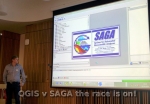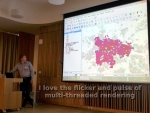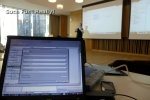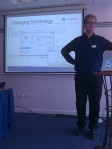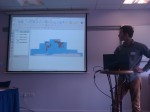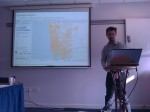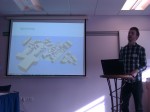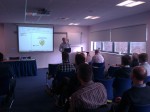Another sold-out event with a programme packed with useful, interesting and delightful talks. Fifty seven (57!) folk blew in from all over Scotland through a freezing rain but hot coffee and pastries were waiting in the Informatics Forum at the University of Edinburgh.
First up was an overview the current status of the QGIS project by Saber from Lutra Consulting. It was good for people new to QGIS and open-source to see how the project is organised and run and the direction it is taking. Pete, also from Lutra Consulting, then gave a quick summary of the bits of core functionality they have been working on including the new ruled based labelling system.
The group then split into two for 90 minute workshop sessions on cartographic labelling and advanced Atlas usage – a tough choice! Chris, from Ordnance Survey, presented a detailed how-to on the new ruled based labelling tools using some OS open data, interspersed with some slides on guidelines to good cartographic practices and labelling tips. The slides and material for this workshop are available here: https://dl.dropboxusercontent.com/u/185489368/QGIS-Scotland2015.pdf
Heikki, from thinkWhere, lead us through the process of using Atlas in Print Composer to automate map production for a series of maps containing a main context map and an inset overview map. Nothing better than doing something once and then being able to repeat it at the click of a button! The slides and material for this workshop are available here: https://github.com/HeikkiVesanto/Scottish_QGIS_User_Workshop
A break for lunch and a good hour of catching up with users from across all sectors – local government, central government, academia, forestry, planning consultancies, developers, student life and education. QGIS is popular and is obviously a flexible tool that meets many demands.
After lunch, Neil, from thinkWhere, organised a quick-fire “quirky QGIS quiz” with random questions from all aspects of FOSS4G demanding quick thinking for true/false answers. At least half the audience grabbed prizes courtesy of thinkWhere and Ordnance Survey.
What followed was a series of lightning talks on different aspects of using QGIS. Amy, from Cawdor Forestry, gave a brief overview of the plugins available in the QGIS plugin repository and highlighted some of her personal favourites. Paul, from Scottish Water, showcased some of the complex workflows created using SAGA, QGIS and the Processing Toolbox to model hydrological process. Ross, from Inverclyde Council, demonstrated the use of the QGIS Road Graph plugin to generate walking routes to school across a custom road and path network. Seb, from West Dunbartonshire Council, showed us how QGIS had put them in a happy place and showed how a “hearts and minds” campaign championing QGIS had changed the way they worked. Steve, fae Embra, gave some information on how to give back to the QGIS project through submitting Processing scripts and plugins to the repository. Don’t reinvent the wheel! Ross, from Angus Council, gave a quick demonstration of setting up a local plugin repository that could be used to share custom plugins or control access to plugins in an internet-less environment.
By this time, tea and cake was required and it gave everyone an opportunity to mix and ask questions of the speakers.
The last session was as series of longer talks started by Gemma, from Ordnance Survey, explaining how open-source software is used extensively at Ordnance Survey to underpin a lot of the cartographic processes and workflows. They use QGIS 2.8 LTR for stability and consistency across the business and a selection of plugins from both OS developers and the community. QGIS is used to generate all the cartographic styles sheets for the OS vector products: https://github.com/OrdnanceSurvey/OS-VectorMap-District-stylesheets
Tom, from EDINA, explained the processing of creating and delivering a QGIS training course to University staff and students. The first class sold out in next to no time and there is demand for more. Makes sense really, doesn’t it?
Steve, from GeoGeo, wrapped up the day with the kind of mapping we’d all like to be doing – high resolution elevation models, time series analysis of shadows, viewsheds across the Edinburgh skyline and analysis of rooftops for potential solar panels with sub 1m resolution LiDAR datasets. He uses a mix of QGIS, SAGA, Blender and other FOSS to inspiring effect. Check his Flickr stream: https://www.flickr.com/photos/stevefaeembra/
The day finished with Pete (Lutra Consulting) releasing into the open a new Search plugin for QGIS called Discovery (http://www.lutraconsulting.co.uk/products/discovery/) based on the PostGIS Search plugin from Tim Martin (Ordnance Survey). A very useful addition to any QGIS installation.
The day was sponsored by EDINA, thinkWhere and Ordnance Survey.
Links to slides will be coming shortly.
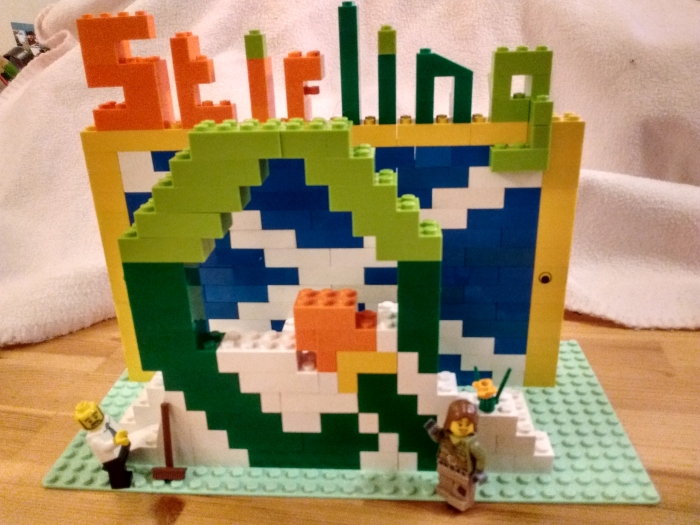








 The 5th QGIS user group meeting in Scotland takes place next Wednesday at the University of Glasgow. It is being hosted by the
The 5th QGIS user group meeting in Scotland takes place next Wednesday at the University of Glasgow. It is being hosted by the 



